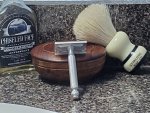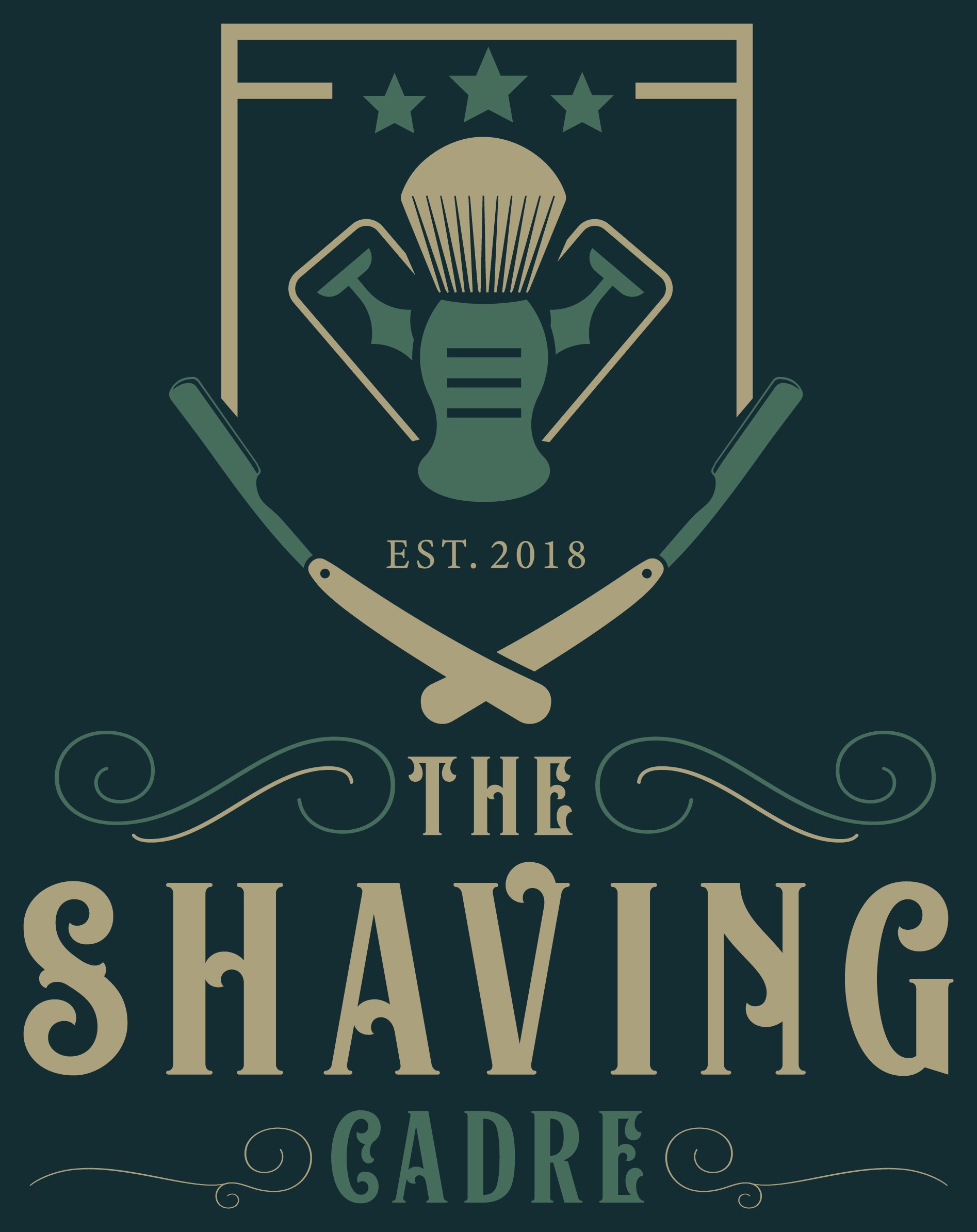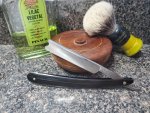Lol I don't want to lose any limbs! I'm digging this thing out of the ground.One word: chainsaw.
The Shaving Cadre
You are using an out of date browser. It may not display this or other websites correctly.
You should upgrade or use an alternative browser.
You should upgrade or use an alternative browser.
uacowboy's razor rodeo
- Thread starter uacowboy
- Start date
Oh, OK. I just like power tools.Lol I don't want to lose any limbs! I'm digging this thing out of the ground.
If I could I would!Oh, OK. I just like power tools.
As a side note my axe head is about to come off the handle. Its one of those Stanley yellow plastic ones currently that was attached with resin of some kind. I had allowed someone to borrow it and the used the back of the head as a hammer and the resin is now busted up and coming out. @Blade-meister if you could direct me to a good video of hanging the head on a new handle id appreciate it. I'm definitely doing a wood handle for the replacement.
Been really busy actually and just saw this. I didn't watch any videos on hanging an axe head but I can walk you through it. If the handle is one of those plastic ones, you'll need another one and I'd go with wood. If you want to do it right, measure the eye of the axe head and go to House Handles and order a straight handle that fits the eye dimensions or is bigger than the eye. Try to find the length that your yellow one is, but longer is better than shorter.
I make my own handles these days and just finished fitting a very sweet Sandvik hatchet head (awesome Swedish steel) to a hickory handle that I worked down from a piece of aged hickory split out from a nice log years ago. I'm guessing you will buy your handle so if you don't go through House Handles, go to the hardware store but make sure the grain runs straight from end to end. If it runs off to either side the handle will likely break on you. Conventional opinion is the the end grain needs to be up and down and not across. I don't believe that and it has it roots in the first settlers from Europe having to use the sapwood because most of their trees had rot in the heartwood centers, thus the grain was always running in the same direction as the axe blade. I stay away from the fancy curved handles and like straight axe handles. The old timers used only straight and they wouldn't touch the curved ones with fawn's feet ends.
Ok, so now you have your handle. You've got that crappy residue of epoxy left in the eye and all that must be removed down to bare metal. One might think you could use a torch to melt it out, but you might ruin the temper of the axe head. I've heard you have to chisel it out with an old chisel but I think a grinding tool of some kind would work if you used a breathing mask. Once the axe head is clean, do an initial fit up to the end of the axe. Usually the new handle is wider than the hole for the eye. I line up the blade with the axis of the handle and trace the shape of the eye on the end of the new axe handle. Then it's just a matter of removing wood down to that mark, fit the axe head on and then (this is key) tap the end of the handle farthest away from the axe head. This is why it's called hanging the axe head. It seems this would be the wrong way and that the axe head would come off, but trust me this works better than pounding the axe head onto the handle (which is the wrong way to do it). Once the head meets resistance and wont go any further trace the back side of the eye on the handle and then tap the axe head off with a rubber mallet. Remove more wood and repeat this until the head is on and meets the sell of the end of the handle. You should have some handle sticking out past the eye and that's good. Tap the head off again with a rubber mallet (tap the blade then the poll back and forth until the head comes loose). Now you need to cut a kerf (slot) in the end that you just fitted to the axe head. The kerf runs the long way up and down. Find the center and cut the kerf with a saw. Your kerf should run almost the full depth of the eye. This is where you put your wooden wedge. If your handle came with a wedge, great. If not, make your own wedge. Once you have your wedge, put some wood glue on it and drive it in the kerf with a wooden mallet until it won't go in any further. I can tell by the sound when it's in all the way. It's ok if your wedge doesn't go in all the way, mine never do. Let the whole thing dry overnight then cut the end almost flush with the eye with a saw. You should have yourself a better axe now! I add Swel-Lock to the end to swell the grain permanently so the wood won't swell and shrink in the area of the eye and loosen up over time. Never put those metal wedges in the ends like you see people doing. Yes it does help with expanding the wood and making things tighter but if you have to replace the handle again some day, drilling out a wood wedge is easy but getting those metal wedges out is a real chore.
With that said, read what I wrote and then go surfing on YouTube and it will all make better sense.
I will translate: BUY MORE STRAIGHT RAZORS.What I just read was kwnkd asijsk iodid cfoe Buy a new one sidjaslidj xisn eifhif admka sdiasi
Thanks! I will probably have to check out House Handles. i went to my local ACE today(which happens to be the biggest one i have ever seen and is awesome) and they didn't have any replacement handles and were not sure when they would be getting any. I knew i wanted wood for the replacement for sure because the plastic one was terrible. to much flex and LOTS of hand shock, even on good strikes. In a way i got lucky because the reason the head came off the handle is all of the epoxy crap shattered and fell out so no major cleanup of the eye is needed, might smooth down a few sharp edges a tad though. the head is for sure the Collins Axe 2.25lb head.Been really busy actually and just saw this. I didn't watch any videos on hanging an axe head but I can walk you through it. If the handle is one of those plastic ones, you'll need another one and I'd go with wood. If you want to do it right, measure the eye of the axe head and go to House Handles and order a straight handle that fits the eye dimensions or is bigger than the eye. Try to find the length that your yellow one is, but longer is better than shorter.
I make my own handles these days and just finished fitting a very sweet Sandvik hatchet head (awesome Swedish steel) to a hickory handle that I worked down from a piece of aged hickory split out from a nice log years ago. I'm guessing you will buy your handle so if you don't go through House Handles, go to the hardware store but make sure the grain runs straight from end to end. If it runs off to either side the handle will likely break on you. Conventional opinion is the the end grain needs to be up and down and not across. I don't believe that and it has it roots in the first settlers from Europe having to use the sapwood because most of their trees had rot in the heartwood centers, thus the grain was always running in the same direction as the axe blade. I stay away from the fancy curved handles and like straight axe handles. The old timers used only straight and they wouldn't touch the curved ones with fawn's feet ends.
Ok, so now you have your handle. You've got that crappy residue of epoxy left in the eye and all that must be removed down to bare metal. One might think you could use a torch to melt it out, but you might ruin the temper of the axe head. I've heard you have to chisel it out with an old chisel but I think a grinding tool of some kind would work if you used a breathing mask. Once the axe head is clean, do an initial fit up to the end of the axe. Usually the new handle is wider than the hole for the eye. I line up the blade with the axis of the handle and trace the shape of the eye on the end of the new axe handle. Then it's just a matter of removing wood down to that mark, fit the axe head on and then (this is key) tap the end of the handle farthest away from the axe head. This is why it's called hanging the axe head. It seems this would be the wrong way and that the axe head would come off, but trust me this works better than pounding the axe head onto the handle (which is the wrong way to do it). Once the head meets resistance and wont go any further trace the back side of the eye on the handle and then tap the axe head off with a rubber mallet. Remove more wood and repeat this until the head is on and meets the sell of the end of the handle. You should have some handle sticking out past the eye and that's good. Tap the head off again with a rubber mallet (tap the blade then the poll back and forth until the head comes loose). Now you need to cut a kerf (slot) in the end that you just fitted to the axe head. The kerf runs the long way up and down. Find the center and cut the kerf with a saw. Your kerf should run almost the full depth of the eye. This is where you put your wooden wedge. If your handle came with a wedge, great. If not, make your own wedge. Once you have your wedge, put some wood glue on it and drive it in the kerf with a wooden mallet until it won't go in any further. I can tell by the sound when it's in all the way. It's ok if your wedge doesn't go in all the way, mine never do. Let the whole thing dry overnight then cut the end almost flush with the eye with a saw. You should have yourself a better axe now! I add Swel-Lock to the end to swell the grain permanently so the wood won't swell and shrink in the area of the eye and loosen up over time. Never put those metal wedges in the ends like you see people doing. Yes it does help with expanding the wood and making things tighter but if you have to replace the handle again some day, drilling out a wood wedge is easy but getting those metal wedges out is a real chore.
With that said, read what I wrote and then go surfing on YouTube and it will all make better sense.
I'm still planning to get the head a new handle but i needed an axe fast so i can get those devil plants out of my yard so i ended up picking up a 4lb axe with a wood handle.(i mean, why not get a bigger one so i have options right?) This one should help a lot once i have a decent edge on it which i hope to do this weekend.
Thanks again! this should be a fun project!
Patelliott
"I NEED NurseDave's Energy"
Yeah my dogs get blamed a lot for stuff around my house. Luckily a treat is all they need for me to win back their affection. Nice post!

Nice easy shave today. Decided to use the tech and take it easy around the still healing damage from yesterday.
After the shave I did notice something however. It seems I've found my first grey hair. My wife thought it was pretty funny. At first I thought I'd somehow gotten a shed hair from one of the dogs with white fur but this was attached! Lol the real question is, am I more distinguished now?
Patelliott
"I NEED NurseDave's Energy"
Yup I noticed a few white hairs in my beard back when I had it. Next day I shaved it off. I used to always shave in the spring/summer and grow my beard out in the fall/winter, but I don't know if I'll do that this year.
Dont worry your Barber is an expert on Hair & Beard color HAHAHAHAView attachment 22776
Nice easy shave today. Decided to use the tech and take it easy around the still healing damage from yesterday.
After the shave I did notice something however. It seems I've found my first grey hair. My wife thought it was pretty funny. At first I thought I'd somehow gotten a shed hair from one of the dogs with white fur but this was attached! Lol the real question is, am I more distinguished now?

if i tried to grow one my beard would be worse than @Cvargo 's. but i still have some dignity so i choose to go fully clean shaven. lolYup I noticed a few white hairs in my beard back when I had it. Next day I shaved it off. I used to always shave in the spring/summer and grow my beard out in the fall/winter, but I don't know if I'll do that this year.
You already look like you have more facial hair than Chad LOLif i tried to grow one my beard would be worse than @Cvargo 's. but i still have some dignity so i choose to go fully clean shaven. lol
i said worse not less. it's just very patchy and doesn't join up in most of the key areas. I could just go with a chin beard but those never look good by themselves.If your facial hair growth is less than mine... Do you really need to shave?
i said worse not less. it's just very patchy and doesn't join up in most of the key areas. I could just go with a chin beard but those never look good by themselves.
Yea... I get it. But hey... Mines really not that bad... I feel like it's respectable

